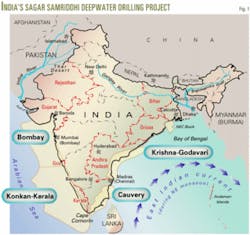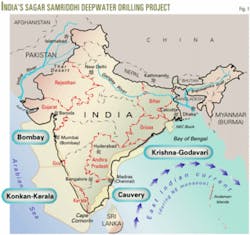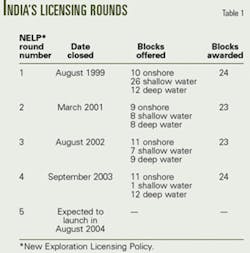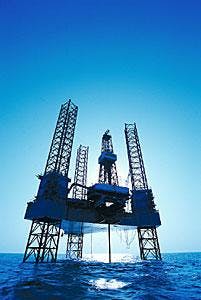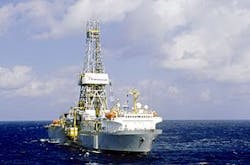Vibrant activity emerging in India to meet rising oil demand
DRILLING MARKET FOCUS
India's push to bolster oil and gas sufficiency has sparked an upsurge in drilling there. The country currently produces about 460 MMboe/year of oil and gas--about 30% of demand--and is targeting 70% self-sufficiency in oil, as demand is expected to rise 6.5%/year through 2010. The US Energy Information Administration estimates India was the world's sixth largest consumer of oil (2.2 million bo/d) and the ninth largest net importer (1.4 million bo/d) in 2002.1
There were 34 rigs drilling in Indian waters in late July, using about 10% of the active worldwide fleet of offshore drilling units. In late June, Simmons & Co. International analysts said that India's use of jackups has, peaked at 27, exceeding the previous high of 26 jack ups operating in 1997.2 They predict an incremental increase in demand for 2-3 rigs/year through 2007, to enable development drilling of the 21 oil and gas discoveries made since spring 2001.
India's Ministry of Petroleum & Natural Gas (MOPNG) is responsible for all oil and gas activities in the country, with the Directorate General of Hydrocarbons assisting and advising in exploration and production.
Challenging environment
Strong surface currents related to seasonal monsoons in the north Indian Ocean present a challenge to drilling off India (Fig. 1). Beginning in late May to early June and lasting until October, winds blow from the southwest. This annual southwest monsoon brings heavy rain to the Kerala (west) coast of India and surface currents move northwest from the Indian Ocean into the Arabian Sea.
In October, strong winds begin to blow from the northeast and bring heavy rain to the east coast (Tamil Nadu) through December. When the monsoon winds change, the north equatorial surface current, also known as the northeast monsoon drift, flows to the southwest and cyclones strike in the Bay of Bengal.
Transocean's Guy Cantwell told OGJ that currents up to 5 knots are normal, equivalent in power to 60-knot winds, and swells commonly reach 8-10 ft. Precise rig positioning becomes critical and operators strive to maintain headings of dynamically positioned drilling units into the surface current.
Operators
India's state-owned Oil & Natural Gas Corp. is 84% government owned, holds 57% of leased acreage, and produces about 84% of India's oil and natural gas. ONGC intends to increase crude production by 10% by 2006-07 and wants to double its reserves by 2020, to 12 billion tones from six billion tonnes. The company expects one third of the increase from onshore production, and two thirds from deepwater production.
State-owned Indian Oil Corp. is the largest company in India, with $1.6 billion net profit for the year ending Mar. 31, 2004. IOC and ONGC are the two largest state oil and gas companies; others are Hindustan Petroleum Corp. and Bharat Petroleum Corp. Ltd.
Foreign companies began participating in bidding rounds under the new exploration licensing policy in 1999. Four licensing rounds have resulted in awards of 94 blocks; 51 went to ONGC (Table 1). MOPNG will announce the fifth licensing round this month.
India's largest private refiner, Mumbai-based Reliance Industries Ltd., holds 27% of leased acreage and has made two giant discoveries in the last two years—a 14 tcf field in the Krishna-Godavari basin (October 2002) and a large field in the Orissa block (June 2004).
The company was drilling two wells in late July. The Transocean Nordic jack up was drilling the NEC-25-AZ well in 229 ft water (Fig. 2) and the Discoverer 534 drill-ship was drilling the D6-M1 well in 4,337 ft of water.
Gujarat State Petroleum Corp. Ltd. was using Saipem SpA's Perro Negro 3 jack up rig to drill the KG-OSN-2001/3 well off Andhra Pradesh.
In 1998, GSPC constructed India's first and only land-based drilling platform, 1.5 km off Hazira, in 8-10 m water. GSPC is partnered with Niko Resources in the Hazira field, with 5 wells producing onshore and 15 offshore.
Calgary's Niko Resources Ltd. has a working interest in 328,796 gross developed acres in India (51,505 net), and 5,405,744 gross undeveloped acres (629,224 net). In 2003, the company participated in 17 exploration wells (71% success), 3 development wells (100% success), and 3 appraisal wells (67% success).
Hardy Oil & Gas PLC is using Northern Offshore Ltd.'s Energy Searcher drill-ship. British Gas PLC is using the Ensco 50 jack up to drill the Panna C Platform in 150 ft of water.
Rig fleets
Houston-based Transocean Inc. is providing 10 of the rigs currently offshore India, including 8 of the company's 26 jack ups and 2 of the 12 deepwater drillships, as of Aug. 2. The company's semisubmersible rig Actinia was also en route to India from Egypt in late July.
In an introduction to the company's May 13 proxy statement, Chairman J. Michael Talbert and President and CEO Robert L. Long noted that the "outlook for the offshore contract drilling business is improving," partly due to rapid expansion in India.
Aban Loyd Chiles Offshore Ltd.
(ALCO) was incorporated in 1986 and has India's largest private offshore contract drilling fleet. ALCO owns and operates three offshore rigs, the Aban II, Aban III, Hitdrill-I, and the Tahara floating production facility. These rigs can drill in waters up to 300 ft deep.
ALCO and Norway's Frontier Drilling AS formed the joint venture Frontier Aban Drilling (India) Ltd. for drilling in deeper water. Frontier Aban has used the Frontier Ice drillship for operations on Bombay High.
Indian-based Jagson International's lone jack up rig, the Deep Sea Matdrill, is currently working in the Bombay High field under contract to ONGC. The rig was working near the mouth of the Tapti River but suspended operations in June after tilting 4.5º. Deep Sea Matdrill had a similar accident last year and was fitted with a new mat in Dubai. It has been back at work for ONGC since February 2004.
J.P. Jindal Group subsidiaries, Jindal Drilling and Industries Ltd. and Neptune Exploration and Industries Ltd., maintain a small fleet of drilling rigs. Neptune has been operating an independent leg, cantilevered jack up in Mumbai offshore since 1997. The company has drilled high-angle directional wells and multilaterals working for ONGC.
Offshore investment
ONGC is investing in new seismic off the east and west coasts. Compagnie Générale de Géophysique group was the low bidder on a seismic tender that closed July 7 to shoot 12,946-sq km 3D survey. ONGC also plans a 6,700-line km 2D survey on both coasts and opened the bid tender on July 1.
The company has deepwater projects in the Kutch, Kerala-Konkan, Krishna-Godavary, and Cauvery basins and plans to drill 47 wells in the Sagar Samriddhi deepwater campaign, using three drillships: Belford Dolphin, Discoverer Seven Seas, and Sagar Vijay. ONGC chairman and managing director Subir Raha said, "Sagar Samriddhi ["prosperity through the oceans"] represents the future for Indian exploration and production. Globally, experience in developing deepwater blocks has demonstrated that the risks are worthwhile."
ONGC was drilling 29 wells off India in late-July, utilizing 24 jack ups, 4 drill ships, and a drilling barge. This included 2 wells in the Bassein field, 1 in Neelam field, one in Tapti, 3 in Bombay basin, 7 on Bombay High, 2 on the Mumbai High, and scattered others.
ONGC has recently drilled three dry holes in deep water off the west coast in the Gulf of Kutch, using the Belford Dolphin drillship. In November 2003, the first well of the Sagar Samriddhi project, GKDW-CA-1, was spudded in 6,048 ft of water, 112 miles offshore. The second well was abandoned and the third well, DW-RO-1A, was announced dry on July 14.
After the third location came up dry, ONGC moved the drillship 100 miles and spud a well on the GS-GW-2A location on July 9, with a planned 4,130 m TD. According to PetroWatch, ONGC engineers are apprehensive about encountering hydrates while drilling GS-GW-2A. They said the area "is known for gas hydrates and Belford will have to deal with them."
The company primarily wants to drill the KS-8 location, but has been waiting for approval from the oil ministry, MOPNG, since February. The wellsite is in 2,000-m waters, only 18 nautical miles from India's maritime border with Pakistan. If the ministry does not grant permission to drill at KS-8, ONGC will move the Belford Dolphin to the Mumbai offshore.
Reliance Industries Ltd. had better luck in Kutch in 2002, with a significant gas find in the GK-OSJ-1 field.
ONGC is also drilling in deep water off the east coast, using Transocean's Discover Seven Seas drill-ship at the KD-3-1 location. As of July 9, they had drilled 2,850 m toward the 4,300-m TD. The Discoverer Seven Seas is capable of working in water as deep as 7,000 ft and can drill to 25,000 ft. It is under contract to ONGC for the deepwater campaign until February 2007.
Cairn has made a number of discoveries offshore eastern India in the Krishna-Godavari basin, beginning with development of the Ravva oil and gas field in the 1990s. The company operates the PFGM-1 lease and retains a 22.5% share. Cairn's share of Ravva production was 12,055 boe/d in 1999 but declined to 10,562 boe/d in 2003.
In 2000-01, the company drilled elsewhere in the Krishna-Godavari basin, but agreed to relinquish a 90% exploration interest in Block KG-DWN-98/2 to ONGC. Cairn also gave up its 50% interest in Block KG-OS/6.
In 2002-03, Reliance made a discovery in the Krishna-Godavari basin, now assessed at 8.6 tcf.
Reliance Industries Ltd. (90%) operates the KG-DWN-98/3 (Block D-6) off eastern India; Calgary-based partner Niko Resources Ltd. holds 10%. The block covers 1.9 million acres and was awarded after India's first international bid round. Reliance and Niko drilled the Dhirubai A-1 discovery well and 7 additional wells in 2003, using Transocean's Discoverer 534 drillship.
Seven of the wells tested gas and five flowed 29-41 MMcfd. An independent assessment by Dallas-based petroleum consultants DeGolyer & MacNaughton determined 241 bcf (probable) and 288 bcf (possible) reserves; Reliance estimates 14 tcf of gas in place in Block D-6.
The Transocean Nordic jack up was drilling in 300 ft water off India for Reliance Industries (Fig. 2; photo courtesy of Transocean Inc.).
In March, the companies announced two new gas discoveries in the D-6 block—the K-1 and K-2 exploration wells were drilled east of the Dhirubhai field, and tested about 30 MMcfd.
Reliance operates offshore Block NEC-25, covering 3.5 million acres; partner Niko has a 10% working interest. Several rollover anticlines were identified on 2D and 3D seismic, each with potential Miocene reserves of 1-2 tcf. The companies drilled three successful wells in 64-84 m water, as of June. According to the Niko's 2003 annual report, first production from NEC-25 is expected in 2005.
Onshore India
Cairn Energy PLC announced in February that it would invest $100-150 million developing oil in the Thar Desert, Rajasthan State, bordering Pakistan (Fig. 3).
Since 2002, Cairn has been involved in an extensive exploration and appraisal program across the company's 5,000 sq km exploration block (RJ-ON-90/1) in the Rajasthan basin. Cairn has 100% interest in the block after buying out Royal Dutch/Shell, but it has ceded a 30% development right to ONGC following commercial discoveries.
After initially drilling in the central and southern parts of the block, Cairn began to focus on the northern third, and the company has already drilled and discovered the Mangala, NA, and NC fields. In July, the company received approval to extend the limits of the block northward to encompass the NC field reservoirs, discovered in March. This increases the block by 850 sq km.
The main exploration play objectives in the basin are the Thumbli, Dharvi Dungar, Barmer Hill, and Fatehgarh formations.
Cairn drilled six appraisal wells in the Mangala oil field, northern Rajasthan, following its 2003 Mangala-1 discovery. Interference tests have established connectivity of the Fatehgarh reservoir sands across the field. The company began a 3D seismic survey over the Mangala and NA fields in May and expects to complete it in fourth-quarter 2004.
Cairn has drilled two more successful wells in the NA field in the Rajasthan basin, the N-B-1 and the N-A-1, northwest of Saraswati, testing 31º API oil from the Fatehgarh sands. The N-A-1 reached 1,634 m TD and found a 120-m column in the Fatehgarh formation, as well as 60-150 m column in the tight, silty Barmer Hill formation. The company estimates 20-80 million bbl preliminary recoverable reserves from the N-A-1 well.
In late July, Cairn's Maryth Guild told OGJ that the company's drilling plans for the remainder of the Indian fiscal year (Apr. 1–Mar. 31), "are focused on Block RJ-ON-90/1 in Rajasthan, where we are drilling approximately five wells/month." Mike Watts, Cairn's exploration director, has overall responsibility for the drilling program.
The company will release an update of its drilling program on Sept. 7, 2004.
Niko Resources operates five fields (Hazira, Bhandut, Cambay, Matar, and Sabarmati) in Gujarat State in western India under production-sharing contracts held since 1994. Hazira extends both on and offshore, and the first production from the offshore portion began in May 2004.
Niko has a 40% working interest in the Bhandut field. The Bhandut-6 well was drilled in March and appears to be a new oil play distinct from other production in the field. The company and partners plan to drill four to six additional wells in 2004.
Cairn will also explore in Bihar, under a March 2004 agreement with the government. Anticipating future frontier exploration in northern India, Cairn has acquired a100%, operating interest in the GV-ONN-2002/1 lease, and a 30% nonoperating interest in the GV-ONN-97/1 lease. The company is also pursuing 100% operating interest in Blocks 1, 2, 4, 6, and 7 in adjacent Nepal.
Cairn has signed a PSC with ONGC for a 30% interest in two blocks in the onshore Cambay basin, CB-ONN-2002/1 and CB-ONN-2001/1, in western India.
Cairn Energy has an active exploration and drilling program onshore India. Here, a rig drills in the Thar Desert, Rajasthan State (Fig. 3; photo courtesy of Cairn Energy PLC).
Gas hydrates
There are several potential gas hydrate accumulations in deep water off the east and west coasts of India. A single cu m of hydrate can contain up to 164 cu m of methane, and India's resource has been estimated at 6,150 trillion cu m, or 142 billion tonnes oil equivalent.
India became the second country in the world, after Japan, to establish a national hydrate research program. In 1996, the Oil Industry Development Board of India allocated $56 million for the program to be managed by the Gas Authority of India Ltd.
In March 2000, India and Russia participated in a hydrate workshop, focusing on joint development of Indian potential resources.3
ONGC's B.K.Varma said that the company targeted the Krishna-Godavari offshore area, after studying reprocessed seismic and finding "very clear" bottom-simulating reflectors "cutting across sedimentary sequences" beyond 800-900 m water depth.3 ONGC geophysicists used stacking interval velocities of 1,500-1,600 m/sec for nonhydrated sediments, and 1,700-1,900 m/sec for hydrated sediments. They estimated the methane hydrate resources of the area at 350-900 billion cu m.
Future frontiers
India's frontier exploration areas for conventional hydrocarbons are the Assam Arakan Fold Belt, the Himalayan Foothills, Mesozoic basins in western India, the Gondwana and Vindhyan basins in central India, and deepwater basins in the eastern offshore.
India has a potential 13.4 tcf in coalbed methane and the government offered seven blocks in the country's first CBM licensing round in 2001, and nine blocks in the second licensing round in 2003. Six blocks from Round 1 were awarded to Reliance, Essar Oil Ltd., and ONGC. Twelve blocks from Round 2 were awarded to ONGC (9) and Reliance (3).
In September 2003, GSPC and ONGC signed three memorandums of understanding covering exploration and development of coalbed methane and laying pipelines over a 10-year period, an investment of about US $500 million.
ONGC has ranked the country's coal provinces in terms of their coal bed methane potential and has engaged in limited frontier exploration. The company drilled two wells in the Durgapur depression of the Raniganj basin and four wells in the Parbatpur block of the Jharia basin.
The Discoverer Seven Seas drillship was drilling the KD-3-1 well, in 5,708-ft water for ONGC (Fig. 4; photo courtesy of Transocean Inc.).
Prudential Securities analyst Grant Borbridge expects the worldwide offshore rig count to average 353 rigs in 2004, increasing 5% from an average 338 active rigs in 2003. The gain can be attributed to increased demand in India and other markets outside the US.
Simmons & Co. International analysts note, "the direction is clear—India will very likely become even more active with respect to drilling."2
References
1. US Energy Information Administration, "Top World Oil Consumers, 2003," and "Top World Oil Net Importers, 2003" http://www.eia.doe.gov/ emeu/cabs/topworldtables3_4.html
2. Gill, S.B., Herbert, W.A., Kentor, J.B., et al., Energy Industry Research report, June 30, 2004.
3. Varma, B.K., et al., "Gas Hydrate Studies – ONGC Approach," in: Proceedings of Indo-Russian Joint Workshop on Gas Hydrates under ILTP, March 2000, http://dod.nic.in/pro/gasright.htm.
